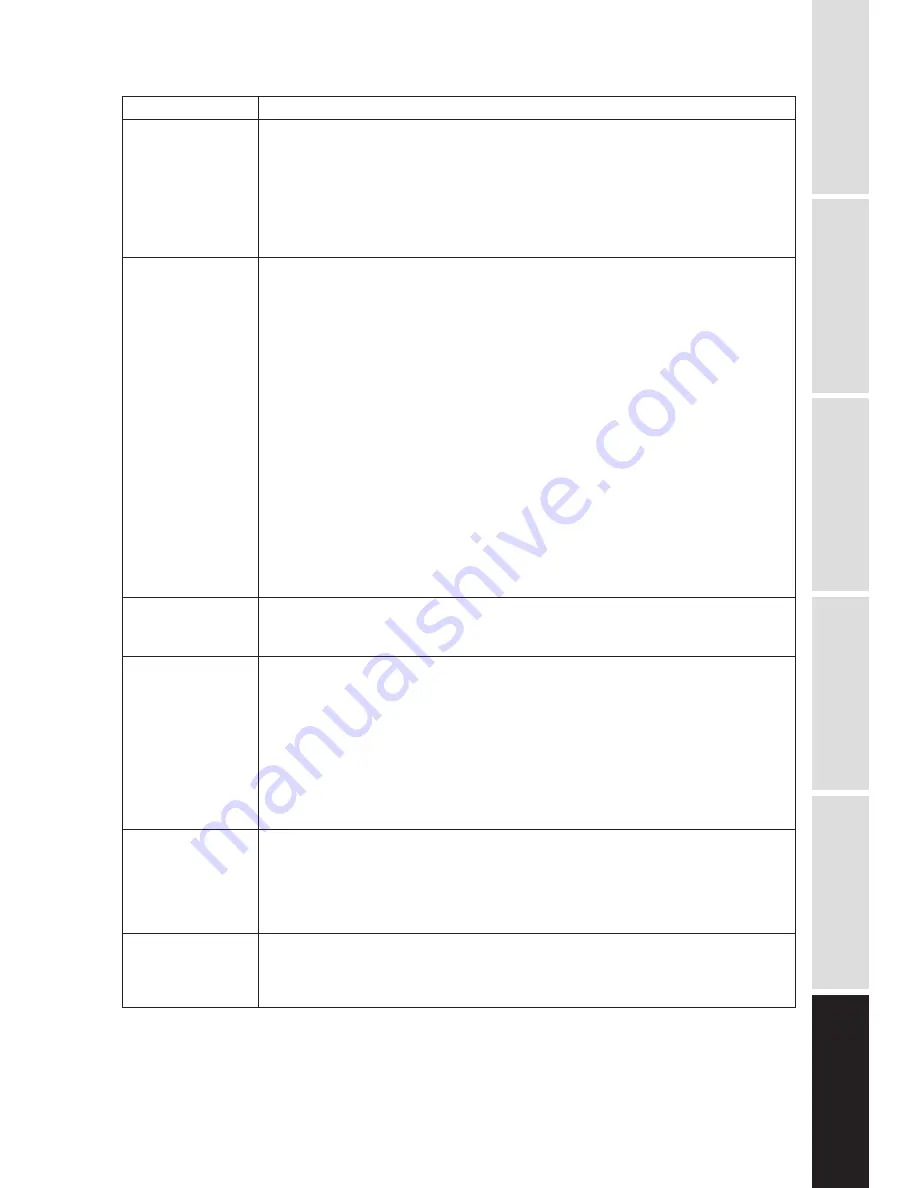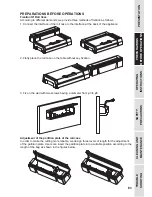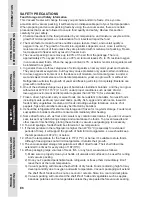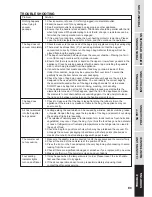
E9
PRESENTATION
PREPARATIONS
BEFORE OPERATIONS
OPERATING
INSTRUCTIONS
SAFETY
PRECAUTIONS
CLEANING AND MAINTENANCE
TROUBLE SHOOTING
Problem
Nothing happens
when trying to
vacuum
package
The bag does not
vacuum completely
The bag does
not seal
Air has re-entered
into the bag after
being sealed
The canister will
not vacuumize
Four sealing
indicator lights
turn on and flicker
Solution
1. Check power cord to see if it is firmly plugged into electrical outlet.
2. Examine power cord for any damages.
3. See if electrical outlet is operative by plugging in another appliance.
4. Ensure that the handle is locked down. The handle should be parallel with the lid
when fully locked. When attempting to lock the lid, change in resistance can be
felt when the locking mechanism is engaged.
5. If it is used for a long time, maybe the over-heating protector is working. Please
open the lid to dissipate the heat for 2-3min, and then continue the operation.
1. Check to make sure the open end of the bag is properly placed along the sealing strip
2. There must be at least 8cm (3") of extra bag material so that the bag will
vacuumized correctly. If there is not enough bag material, the bag will not be
placed flat along the sealing strip.
3. The bag should extend half way across the vacuum chamber. Placing too far in
or not far enough could result in improper vacuum.
4. Ensure that there is no debris or liquid on the upper or lower foam gaskets in the
appliance. Clean by wiping gaskets off with a damp rag and letting the gaskets
air dry, after being removed from the appliance.
5. It should be noted that meats and other food may contain air inside of them.
Under this condition, bags may lose vacuum effect over time. To avoid this,
partially freeze the item before vacuum packaging.
6. Check the type of bag being used. Channeled vacuum bags are the only type
designed to be used with this appliance. You can identify the correct bags by
the special embossed surface of the bag creating channels for air to escape.
DO NOT use any bag that is void of ribbing, meshing, or channeling.
7. If the heating elements get too hot, the sealing process may start before the
elements are turned on. If this happens, open the lid of the appliance and allow
the elements to cool down before vacuumizing again. It is also helpful to leave
the lid open in between cycles to keep the heating elements cool.
1. Check to make sure that the bag is laying flat along the rubber strip in the
appliance. If there are any creases or tears in the bag, the appliance may not
seal correctly.
1. Leakage along the seal which can be caused by wrinkles, debris crumbs, grease
or liquids. Reopen the bag, wipe the top inside of the bag and smooth it out along
the sealing strip before resealing.
2. The release of natural gases or fermentation form foods (such as fresh fruits and
vegetables) may occur. Open the bag, if you think the food has gone bad, discard
it. Lack of refrigeration or fluctuating temperatures in the refrigerator can lead to
the spoil of food.
3. Check the bag for a puncture or hole which may have released the vacuum. Do
not apply the vacuum packaging in hard items with sharp points (like bones or
cracks of nut shell). Cushion sharp edges with paper towels.
1. Make sure the adaptor is well connected to both the appliance and the canister firmly.
2. Check if the knob of the canister is at the position of Seal.
3. Press the lid or on the hose adaptor at the very beginning of vacuuming to avoid
leaking from the cover seal
4. Check if there are significant damages or smashes, if yes, replace with a new one.
5. Make sure the rim of the canister is clean and out of debris.
1. It may happen when the temperature is too low. Please loosen the lock handle
first and then close it to try again.
2. If the above operation doesn’t work, please immediately stop using it and
contact the after-sales service.
TROUBLE SHOOTING






























